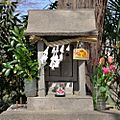Shinto shrine facts for kids
A Shinto shrine is a special place where people practice the Shinto religion. These shrines often have buildings, unique gates, and beautiful natural areas around them. In Japanese, a Shinto shrine is usually called a jinja (神社).
Contents
What is a Shinto Shrine?
Shinto shrines are places for worshipping kami. Kami are spirits or gods in the Shinto religion. People visit shrines to show respect to kami. They also pray for good luck or to thank the kami.
The Role of Kami in Shinto
Kami are important in Shinto. They can be spirits of nature, like mountains or rivers. They can also be spirits of important people or ancestors. Each shrine is usually dedicated to one or more specific kami.
Key Features of a Shrine
Most Shinto shrines share similar features. These include a torii gate, a main hall, and often a purification fountain.
- Torii Gate: This is a special gate that marks the entrance to a shrine. It separates the everyday world from the sacred world of the kami.
- Honden: This is the main building of the shrine. It is where the kami is believed to live. Visitors do not usually enter the honden.
- Haiden: This is the hall where worshippers stand to pray. It is usually in front of the honden.
- Temizuya: This is a water basin where visitors wash their hands and mouth. This act purifies them before approaching the kami.
How People Worship at Shrines
Visiting a Shinto shrine is a peaceful experience. There are a few simple steps people follow to show respect.
- Bowing: Before entering the torii gate, people often bow. They bow again when leaving.
- Purification: At the temizuya, visitors use a ladle to scoop water. They pour water over their left hand, then their right hand. After that, they rinse their mouth and finally pour water over the ladle handle.
- Offering and Prayer: At the haiden, people usually throw a coin into an offering box. Then they bow twice, clap their hands twice, and bow once more. They quietly offer their prayers or wishes.
Types of Shinto Shrines
There are many different kinds of Shinto shrines across Japan. Some are very large and famous, while others are small and local.
Important National Shrines
Some shrines are especially important to the whole country.
- Ise Grand Shrine: This is one of the most sacred Shinto sites. It is dedicated to Amaterasu Omikami, the sun goddess. She is believed to be an ancestor of the Japanese imperial family.
- Izumo Taisha: This shrine is dedicated to Okuninushi no Okami. He is a kami of good relationships and fortune.
Local and Family Shrines
Many smaller shrines exist in neighborhoods and homes.
- Ujigami Jinja: This type of shrine is for the guardian kami of a specific area or family.
- Hokora: These are very small shrines. They might be found by the roadside or in someone's garden. They are for local kami or spirits.
History of Shinto Shrines
Shinto is an ancient religion in Japan. The way shrines look and are used has changed over time.
Early Beginnings
In ancient times, people worshipped kami in natural places. These included mountains, waterfalls, and large trees. There were no buildings at first. Over time, simple structures were built to mark these sacred spots.
Influence of Buddhism
For many centuries, Shinto and Buddhism were closely mixed in Japan. Buddhist temples were sometimes built inside shrine grounds. Shinto kami were even seen as forms of Buddhist deities. This changed in the late 1800s.
Modern Shrines
After 1868, the Japanese government separated Shinto and Buddhism. Shinto shrines became purely Shinto places. Today, shrines continue to be important cultural and spiritual centers in Japan. They are places for festivals, weddings, and daily prayers.
Images for kids
-
Senbon torii leading to the Fushimi Inari-taisha
-
The Yasukuni Shrine in Chiyoda, Tokyo
-
Ujigami Shrine in Uji, Kyoto Prefecture
-
Kayashima Station with the camphor sacred tree growing through it with a shrine at the base
See also
 In Spanish: Jinja para niños
In Spanish: Jinja para niños


























